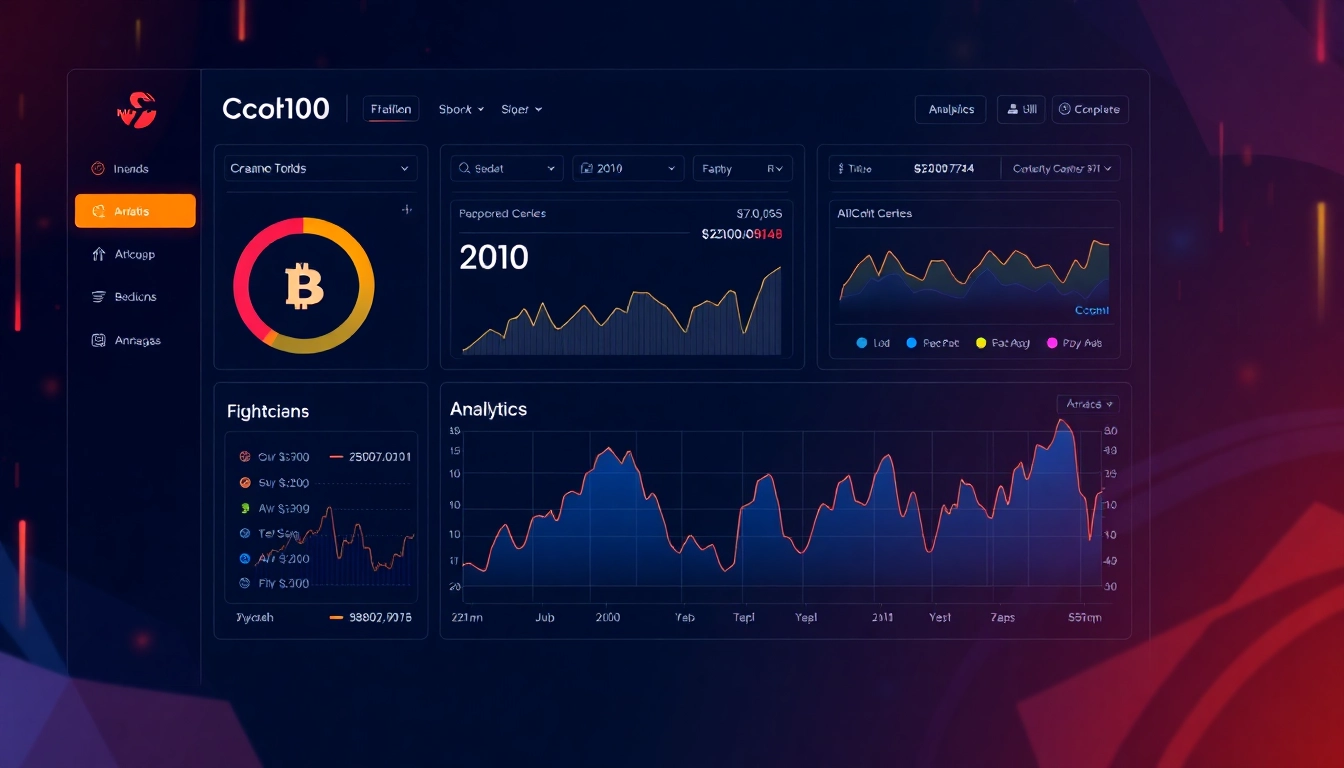Understanding Trading View and Its Core Features
In the fast-paced world of financial markets, having access to reliable, comprehensive, and real-time charting and analysis tools is essential for traders and investors. trading view stands out as a leading platform that combines advanced charting capabilities, social networking, and market analysis into a single interface. Its intuitive design and powerful tools make it invaluable whether you’re a seasoned trader or just starting your investment journey. This article explores the core features of Trading View, how it facilitates effective market analysis, and practical approaches to maximize its potential for better trading decisions.
Introduction to Trading View’s Charting Tools
The heart of Trading View’s offering lies in its sophisticated charting tools. Unlike basic chart providers, Trading View offers a user-friendly yet highly customizable environment that caters to both technical and fundamental analysis. Traders can access a multitude of chart types—including candlestick, line, bar, and Heikin-Ashi charts—allowing them to view market trends from different perspectives. Moreover, the platform supports timeframes ranging from one minute to monthly, offering granular control over data visualization.
One of the platform’s key strengths is its vast library of technical indicators, from simple moving averages to complex oscillators like RSI, MACD, Bollinger Bands, and volume analysis tools. Users can apply multiple indicators simultaneously and customize their parameters to fit their unique trading strategies. The ease of toggling between different indicators, combined with real-time data updates, offers traders the clarity needed to identify potential entry and exit points effectively.
Importantly, Trading View has pioneered the integration of drawing tools directly onto charts, including trendlines, Fibonacci retracements, support/resistance zones, and pitchforks. These visual aids are crucial for pattern recognition and trend confirmation. For example, traders often use Fibonacci levels to predict potential reversal zones during corrections, enhancing their strategic planning.
Exploring Social Features and Community Insights
Beyond its technical tools, Trading View has cultivated a vibrant social community where traders share ideas, insights, and analyses. This social dimension transforms the platform from a mere charting tool into an interactive marketplace of knowledge. Users can publish their analysis as “ideas,” which others can comment on or replicate, fostering collaborative learning and collective market intelligence.
Access to community ideas provides traders with diverse perspectives and alternative viewpoints, which can be invaluable in volatile markets. For example, a well-analyzed idea about a potential breakout can prompt traders to re-evaluate their positions. The platform’s chat options and live streams also facilitate real-time discussions, enabling traders to stay updated on latest trends, news, and market sentiment.
Furthermore, Trading View’s social network offers seamless sharing of charts and strategies across platforms such as Twitter and Telegram. These integrations amplify your reach and enable instant dissemination of trading insights, making social collaboration an integral part of market analysis.
Utilizing Alerts and Custom Watchlists for Effective Trading
Effective trading hinges on timely information. Trading View addresses this by allowing users to set customized alerts based on price levels, indicator values, or drawing tools. Alerts can be configured to trigger sound notifications, emails, or even SMS, ensuring traders never miss critical market moves. For instance, setting an alert at a specific support level can notify you immediately if the price drops, alerting you to potential buying opportunities.
Complementing alerts are customizable watchlists that enable traders to monitor multiple assets simultaneously. By organizing stocks, cryptocurrencies, forex pairs, or commodities into watchlists, traders can keep an eye on relevant markets without cluttering their workspace. The platform offers quick access to live price updates, technical data, and news, empowering traders to make well-informed decisions swiftly.
Practical implementation involves creating multiple watchlists tailored to various trading strategies—such as swing trading, day trading, or long-term investing—and setting alerts based on your specific criteria. This systematic approach enhances discipline and helps manage multiple positions effectively.
How to Leverage Trading View for Advanced Market Analysis
Analyzing Stocks, Cryptocurrencies, and Forex Markets
Trading View provides robust data across global markets, including stocks, cryptocurrencies, and forex. Its interactivity allows traders to analyze assets in depth, utilizing a shared universe of data. For example, cryptocurrency traders can track Bitcoin or Ethereum on real-time charts, analyze volume and momentum indicators, and compare their movements against traditional assets like gold or the S&P 500. Similarly, forex traders can evaluate currency pairs with tools like pivot points and trendlines, identifying strategic entry points.
Integration of fundamental data, such as earnings reports or economic indicators, complements technical analysis, providing a holistic view. Moreover, Trading View’s comprehensive screener tools allow filtering assets based on technical criteria, market capitalization, volume, or other metrics—streamlining asset selection and enhancing efficiency.
Integrating Technical Indicators and Drawing Tools
Technical analysis on Trading View is further enhanced by the ability to combine multiple indicators and drawing tools seamlessly. Traders often overlay moving averages (e.g., 50-day and 200-day) to identify trend directions, while oscillators like RSI highlight overbought or oversold conditions. Combining these signals helps confirm trade setups.
Drawing tools augment this by marking key levels, such as support and resistance zones or Fibonacci retracement levels, which visually aid decision-making. For example, a trader might draw trendlines connecting swing lows to define an uptrend, then add Fibonacci levels to forecast correction targets.
Implementing Trading Strategies with Trading View’s Scripts
Trading View supports custom scripting through its proprietary scripting language, Pine Script. This feature enables traders to develop and deploy their own algorithms, backtest strategies, and automate signals — offering an edge in dynamic markets. Many traders leverage pre-built scripts available in the community to identify patterns such as moving average crossovers, breakout signals, or candlestick formations.
For instance, a trader might implement a simple strategy: buy when the 20-period moving average crosses above the 50-period, and sell when it crosses back below. By backtesting these scripts on historical data, traders can gauge strategy performance and fine-tune parameters before deploying in real markets.
Best Practices for Maximizing Trading View’s Potential
Creating Efficient and Customizable Trading Setups
The key to effective trading is a tailored setup that aligns with your trading style and risk tolerance. Start by customizing your workspace—organize multiple charts with different timeframes and assets, set preferred indicators, and save templates. This consistency allows for rapid analysis, especially during volatile market hours.
Utilizing Trading View’s hotkeys and keyboard shortcuts streamlines workflow, while creating pre-defined alert groups simplifies monitoring multiple scenarios. Regularly updating your setups based on changing market conditions ensures your analysis remains relevant and accurate.
Using Trading View on Mobile and Desktop Seamlessly
Accessibility is crucial in high-frequency trading environments. Trading View offers synchronized experiences across mobile apps and desktop browsers. The mobile app supports most desktop features, including customizable charts and alerts, with added convenience for on-the-go monitoring. The desktop platform provides advanced drawing and scripting capabilities for in-depth analysis.
Synchronization across devices ensures that your watchlists, indicators, and settings are consistent. This seamless integration allows traders to react swiftly to market movements at any time.
Collaborating and Sharing Ideas Within the Trading Community
Collaboration is a core advantage of Trading View. Sharing charts or analysis ideas with the community can lead to valuable feedback, alternative viewpoints, and even collaborative trading strategies. Group discussions and comment sections facilitate active engagement, making the platform not just a tool, but a marketplace of shared knowledge.
For example, a trader analyzing a breakout pattern can publish their idea, inviting comments from experienced analysts. Similarly, participating in trending discussion threads enhances learning and can provide early signals about market sentiment shifts.
Performance Tracking and Enhancing Your Trading Results
Interpreting Market Data and Trend Patterns
Success in trading hinges on accurate interpretation of market data. Trading View’s comprehensive visualizations—such as volume bars, candlestick formations, and trendlines—help traders recognize current trends and anticipate future movements. Identifying patterns like head and shoulders, double tops/bottoms, or flags can provide actionable signals.
Combining pattern recognition with momentum indicators enhances predictive accuracy. For instance, a breakout confirmed by increasing volume often signals a strong move, prompting timely entries.
Setting Alerts and Managing Risk Effectively
Effective risk management involves proactive alert settings. Alerts at critical levels—stop-loss, take-profit, or reversal points—help prevent emotional decision-making. Establishing dual alerts for confirmation enhances reliability. For example, pairing a price alert with an RSI overbought condition reduces false signals.
Regular review of your alert strategy and adjusting thresholds based on market volatility ensures they remain relevant. Additionally, integrating alerts with trading plans fosters discipline.
Measuring Success and Adjusting Strategies Accordingly
Consistent performance evaluation is essential. Trading View offers tools to analyze your trade history, draw performance metrics, and identify strengths and weaknesses. Keeping detailed logs allows for retrospective analysis, helping you refine your approach.
For example, if a strategy produces frequent false signals during high volatility, adjustments such as tighter stop-losses or alternate indicators may be necessary. Data-driven feedback loops foster continual improvement.
Future Trends in Trading View and Market Analysis Tools
Emerging Technologies and Integration Possibilities
As technology advances, trading platforms like Trading View are poised to incorporate more sophisticated tools such as machine learning, AI-driven signals, and real-time news feeds. These integrations aim to automate analysis, surface high-probability setups, and adapt to changing market dynamics dynamically.
The Role of AI and Automation in Trading Platforms
Artificial intelligence can analyze vast datasets to predict market movements more accurately. Automated scripts and trading bots integrated within Trading View can execute trades based on predefined criteria, minimizing emotional bias. Such tools empower traders to implement algorithmic strategies with ease.
Adapting to Changes in Market Dynamics with Trading View
Market conditions are constantly evolving, and effective traders must adapt. Trading View’s flexible infrastructure allows quick customization of analysis parameters, enabling traders to respond promptly to economic reports, geopolitical events, or sudden volatility spikes. Staying ahead requires leveraging ongoing technological innovations and integrating new analysis methods.



